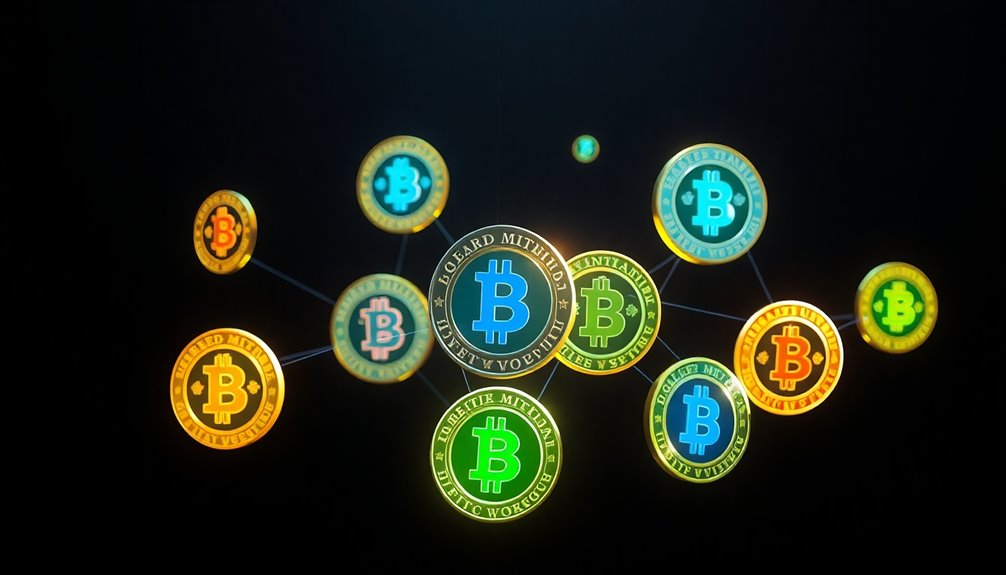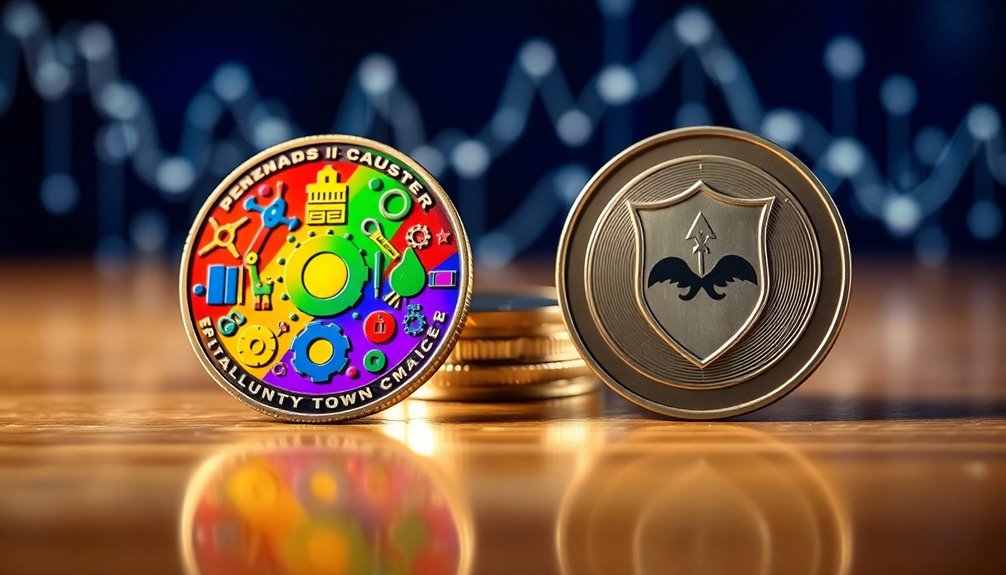Tokenomics is the study of how tokens operate within cryptocurrency ecosystems. It shapes their economic model, utility, and distribution, influencing their value and investor confidence. You've got different token types, like utility and governance tokens, each serving specific purposes. The structure of token supply affects market behavior, while mechanisms like staking encourage user engagement. Understanding these dynamics can help you navigate the risks and rewards of investing in crypto. If you look closer, you'll discover even more intriguing aspects that can enhance your investment strategy and decision-making.
Key Takeaways
- Tokenomics refers to the economic structure and principles governing the supply, distribution, and demand of tokens within blockchain ecosystems.
- It encompasses various token types, including utility, security, governance, stablecoins, and NFTs, each serving distinct purposes.
- Effective tokenomics promotes user engagement through mechanisms like staking, token burns, and governance rights, enhancing community participation.
- Understanding token distribution mechanics, such as allocation methods and vesting periods, helps assess a project's viability and potential investment risks.
- Market volatility can significantly impact token value, with strong tokenomics providing resilience during downturns and fostering investor confidence.
Token Types and Purposes

When diving into the world of tokenomics, it's essential to understand the five main types of tokens and their distinct purposes.
Utility tokens, like Smooth Love Potion (SLP), grant access to specific services within a blockchain ecosystem.
Security tokens represent equity ownership in blockchain companies, making fundraising through Initial Coin Offerings (ICOs) faster and cheaper than traditional methods.
Governance tokens allow holders to influence project decisions, fostering community engagement similar to shareholder voting.
Stablecoins, such as Tether (USDT), aim to maintain a stable value, providing liquidity in the volatile crypto market.
Lastly, non-fungible tokens (NFTs) are unique digital assets that verify ownership of specific items, ensuring authenticity and provenance through blockchain technology.
Tokenomics in the Crypto Ecosystem

Tokenomics significantly shapes the crypto ecosystem by determining how digital tokens are supplied, distributed, and utilized.
The structure of tokenomics directly influences investor confidence and market cap, impacting the economic characteristics of each cryptocurrency. With various models like inflationary and deflationary approaches, the supply and distribution of tokens can drive long-term sustainability.
Effective tokenomics often includes mechanisms such as staking, token burns, and governance rights, which encourage user engagement.
Real-world examples, like Axie Infinity, showcase how tokens serve both utility and governance roles within a blockchain technology framework.
Understanding these dynamics helps you navigate potential risks and rewards as an investor, making tokenomics a crucial element of your crypto journey.
Token Distribution Mechanics Explained

Understanding how tokens are distributed is essential for assessing a project's potential and fairness. Token distribution mechanics dictate how tokens are allocated among stakeholders like founders, investors, and the community. This allocation influences both perceived fairness and engagement within the project.
Common methods include fair launches and pre-ICO sales, which can affect the initial circulating supply. Disproportionate token ownership can lead to increased volatility, as a few token holders may significantly impact market dynamics.
To promote stability, many crypto projects implement vested periods, releasing tokens gradually to prevent market flooding. Understanding these aspects of tokenomic information helps you gauge a project's viability and make informed investment decisions.
Pros and Cons of Tokenomics

While navigating the world of cryptocurrencies, you'll often encounter the term tokenomics, which encompasses both advantages and disadvantages that can significantly impact a project's success.
The pros include effective token distribution strategies that foster community engagement and governance participation, enhancing project sustainability. Token burn mechanisms, like those used by Avalanche, create scarcity, potentially boosting demand and price stability. Furthermore, as seen with new Bitcoin holders controlling 50% of supply, a strong demand can lead to more robust tokenomics frameworks.
However, the cons can't be ignored. Poorly structured tokenomics may lead to speculation and volatility, resulting in significant investor losses, as seen with memecoins like Dogecoin.
Additionally, vulnerabilities in tokenomics models pose risks like "rug pulls" and hacking incidents, undermining trust in the market. Understanding these pros and cons is essential for making informed investment decisions.
Token Utility Versus Security Tokens

When diving into the world of cryptocurrencies, it's essential to grasp the differences between utility tokens and security tokens, as each serves a unique purpose within the blockchain ecosystem.
Utility tokens provide access to services within their platforms, like Smooth Love Potion (SLP) in Axie Infinity, incentivizing user participation.
In contrast, security tokens represent ownership in real-world assets and are subject to regulatory compliance, making them suitable for fundraising efforts like Initial Coin Offerings (ICOs).
Investors looking to buy tokens should note that utility tokens usually don't offer ownership rights or dividends, while security tokens often come with profit-sharing and voting rights.
Understanding these distinctions is crucial for navigating the landscape of tokenomics effectively.
Market Volatility Impacts Token Value

Market volatility can dramatically affect token value, creating an environment where prices can swing wildly based on investor sentiment.
When market volatility is high, you might notice significant price swings that can lead to lower investor confidence. This often results in increased selling pressure, further driving down token prices.
Tokens with lower liquidity are particularly vulnerable, as even small trades can disproportionately impact their market value.
External factors like regulatory news and technological advancements can exacerbate these fluctuations.
However, tokens backed by strong tokenomics and utility tend to recover more quickly during downturns, showcasing their resilience.
Understanding these dynamics is crucial for navigating the unpredictable world of cryptocurrencies and making informed investment decisions.
Emerging Defi Token Models

As the decentralized finance (DeFi) ecosystem evolves, emerging token models are reshaping how users interact with digital assets.
These models often incorporate governance tokens, allowing you to participate in decision-making processes like protocol upgrades and fund allocation.
Liquidity mining and yield farming incentivize you to provide liquidity and stake your tokens for rewards.
Additionally, dynamic supply mechanisms adjust the circulating supply based on market conditions or user participation, influencing token value and stability.
Token burn mechanisms help create scarcity by reducing total supply over time, potentially boosting market value.
Finally, many DeFi token models aim for interoperability, enabling you to use your tokens across various decentralized applications (dApps) and enhancing their utility within the broader ecosystem.
Analyze Token Utility Dynamics

The evolution of DeFi token models directly impacts token utility dynamics, shaping how you engage with various platforms.
Token utility defines a token's functional purpose within its ecosystem, and utility tokens like Smooth Love Potion (SLP) exemplify this. A well-articulated utility enhances demand for the token, as you need it for accessing features, governance rights, or staking rewards.
This effectiveness can significantly influence investor confidence and the long-term viability of projects. You'll find detailed token utility dynamics in a project's whitepaper, outlining the token's role in the overall ecosystem.
Successful DeFi platforms demonstrate real-world applications, enabling you to participate in yield farming, governance voting, or transaction fee payments, thereby boosting demand for the token.
Frequently Asked Questions
What Is an Example of Tokenomics?
One example of tokenomics is Bitcoin, which has a capped supply of 21 million coins. This scarcity creates a deflationary nature, enhancing its value over time.
Another example is Ethereum, where an uncapped supply allows for continuous token issuance to incentivize network participation.
You'll also see Axie Infinity's dual-token system, with AXS for governance and SLP for transactions, showing how different tokens can function together effectively within a gaming ecosystem.
What Is Ethereum Tokenomics?
Ethereum tokenomics involves the ETH token, which you use for transaction fees, staking, and governance in decentralized applications.
Unlike Bitcoin, ETH's supply isn't capped, allowing for continuous issuance. With the EIP-1559 upgrade, a portion of transaction fees gets burned, reducing the circulating supply and potentially increasing scarcity.
Additionally, the shift to proof-of-stake in Ethereum 2.0 incentivizes you to lock your ETH, impacting supply dynamics and encouraging participation.
How Do You Calculate Tokenomics?
To calculate tokenomics, you'll need to analyze key metrics like market capitalization and fully diluted market cap.
First, multiply the current token price by its circulating supply for market cap. For fully diluted market cap, use the maximum supply instead.
Don't forget to check token supply dynamics, inflation rates, and distribution among stakeholders. These factors will give you a clearer picture of a token's potential value and market behavior.
What Is Tokenomics for Crypto Games?
In crypto games, tokenomics refers to the economic structure that governs in-game tokens.
You'll find these tokens used for transactions, governance, and rewards, all designed to enhance your gaming experience.
A well-crafted tokenomics model can incentivize your engagement through staking and rewards.
Conclusion
In summary, understanding tokenomics is crucial for navigating the crypto landscape. By grasping the different types of tokens and their purposes, you can make informed decisions about investments and participation in various projects. Keep an eye on token distribution mechanics and market volatility, as they significantly impact value. As DeFi continues to evolve, staying updated on emerging token models and utility dynamics will empower you to leverage opportunities in this rapidly changing environment.









